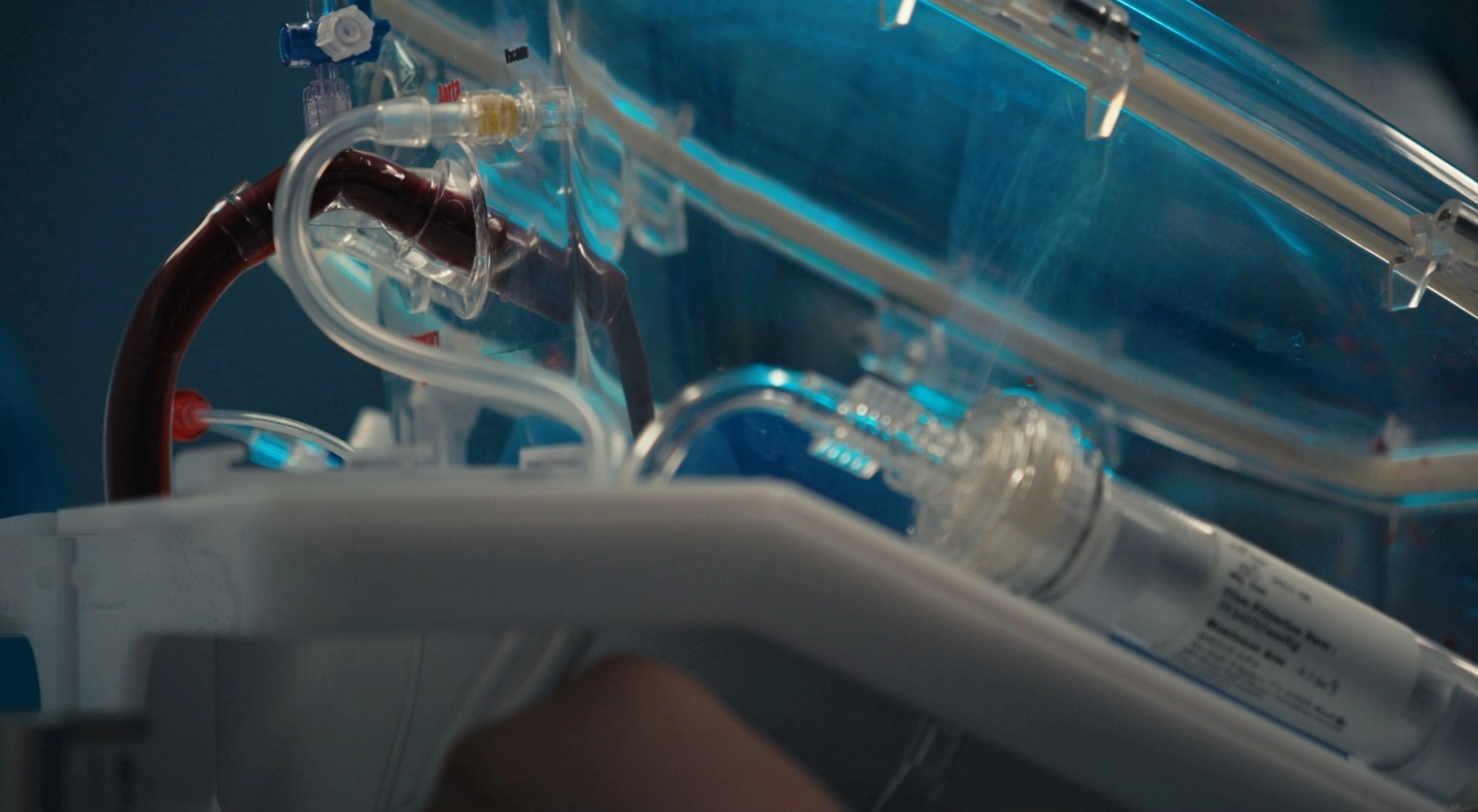Enter Cabinet
ALEM
A technology that gives time — and extends lives 命をつなぎ、時間を与えるテクノロジー
.webp)

.webp)
.webp)
.webp)
.webp)
.webp)
.webp)
.webp)

ALEM (Astana Life Ex-situ Machine) is an innovative medical device developed in Kazakhstan for the preservation, treatment, and transportation of donor organs. The system maintains organ functionality outside the human body for over 24 hours, in conditions that closely replicate natural physiology.
ALEM(Astana Life Ex-situ Machine)**は、カザフスタンで開発された革新的な装置であり、ドナー臓器の保存、治療、輸送を目的としています。本システムは、臓器を人体外で24時間以上にわたり、生理的条件に極めて近い環境で機能させ続けることを可能にします。
Why does it matter?
In transplantation, time is critical. After an organ is retrieved, doctors typically have only 4 to 6 hours before it begins to lose function and becomes unsuitable for transplantation.
In countries like Kazakhstan, where regions are separated by hundreds or thousands of kilometers, and logistics depend on weather and infrastructure, meeting these time constraints can be challenging.
Even when a donor is available and a recipient is ready, a transplant may not happen – simply because time runs out.
なぜALEMが必要なのか?
臓器移植において「時間」は決定的な要素です。摘出後、臓器が機能を失い始めるまでには平均してわずか4〜6時間しかありません。カザフスタンのように、地域間の距離が数百〜数千キロに及び、輸送が天候やインフラに大きく左右される国では、この時間制限の遵守が困難です。ドナーとレシピエントの準備が整っていても、時間が足りなければ移植が実現しないこともあります。
ALEM addresses this challenge.
It extends the available timeframe and makes possible what was previously out of reach.
ALEMはこの課題を解決します。本システムは時間的猶予を拡大し、これまで不可能だったことを可能にします。

How ALEM works
Once retrieved, the donor organ is connected to ALEM – a closed-loop system that maintains continuous circulation of oxygenated blood.
The device keeps the organ in a normothermic state (36–37 °C), preserving natural metabolism.
The organ continues to function – as if it were still inside the body.
Built-in sensors and monitoring systems track all critical physiological parameters in real time: temperature, pressure, gas levels, and more.
Medical teams can not only monitor the organ, but also administer medications, remove excess fluid, and perform procedures such as ultrasound, coronary angiography, bronchoscopy, or CT scanning – effectively beginning treatment before transplantation.
ALEMの基本原理
摘出後、ドナー臓器はALEMシステムに接続され、閉鎖循環回路内で酸素を豊富に含む血液が循環します。
装置内部は36~37℃の常温体温域に保たれ、臓器の代謝活動が維持されます。
臓器はまるで体内にあるかのように機能し続けるのです。
内蔵されたセンサーとモニタリング機能により、温度、圧力、血中ガス濃度などの重要な生理的指標がリアルタイムで監視されます。
医師は臓器の状態を観察するだけでなく、薬剤投与、体液除去、超音波検査や冠動脈造影といった処置も可能です。
移植前から治療を開始することができるのです。

What makes ALEM unique?
ALEM provides a controlled, therapeutic environment that enables donor organs to remain viable and active for more than 24 hours outside the body.
It:
• maintains normothermia (36–37 °C)
• ensures oxygen-rich blood circulation
• allows therapeutic intervention and medication delivery
• offers real-time monitoring of all key parameters
• supports comprehensive organ assessment – Including imaging and diagnostic procedures
This enables doctors to both preserve and optimize organs for transplantation, improving outcomes for recipients.
体外の生命活動:ALEMのユニークな特性
ALEMは、ドナー臓器を24時間以上にわたり体外で保存・機能維持できる環境を提供します。
装置の特徴:
常温体温域(36~37°C) を維持
酸素化された血液の循環を実現
薬剤投与や体液除去が可能
全ての重要パラメーターをリアルタイムで監視
冠動脈造影、超音波検査、気管支鏡検査、CTなどによる臓器評価が可能
これにより、臓器の保存だけでなく、レシピエントの状態に合わせた最適な準備が行えます。
Designed for real-world use
ALEM is built for practical application in diverse clinical settings:
– Compact and mobile: 45 × 55 × 120 cm, up to 50 kg
– Operates on standard 110–220 V power supply
– Equipped with integrated life-support modules and an onboard oxygen supply
– Suitable for transport by car, train, or aircraft
– Constructed from biocompatible materials, with locally manufactured disposable modules
実用性に特化した革新技術
ALEMは、臨床現場での使用を前提に設計されています。
コンパクトでモバイル性に優れる:45×55×120cm、重量50kg以下
110〜220Vの標準電源に対応
ユニバーサルで移動可能な生命維持装置を搭載
車両、鉄道、航空機での輸送に対応
生体適合性の高い素材を使用し、消耗モジュールは現地生産

Project status
Since 2022, 42 preclinical procedures have been successfully completed using heart, liver, and lung models.
These studies have demonstrated ALEM’s ability to preserve active organ function for over 24 hours, while enabling early treatment.
Preparation is now underway for the first clinical application of ALEM in a real transplant setting.
Construction of the first dedicated production facility has also begun.
プロジェクトの進捗状況
2022年以降、42件の前臨床手術を実施。
心臓、肝臓、肺における実験で有効性が確認されました。
24時間以上の臓器の生命維持・機能保持・治療実施が可能であることが証明されています。
現在、初の実臨床使用に向けた準備が進められており、生産拠点の建設もスタートしました。
Who developed ALEM?
ALEM is a joint initiative of the UMC Heart Center and the Heart Center Foundation - Kazakhstan’s first non-profit dedicated to advancing cardiac surgery and transplant science.
The team includes:
cardiac surgeons, anesthesiologists, perfusionists, biomedical engineers, morphologists, lab specialists, researchers, and administrative experts.
Scientific leadership is provided by Academician Dr. Yuriy Pya, one of Kazakhstan’s renowned cardiac surgeons.
ALEMを創ったのは誰か?
本プロジェクトは、UMC心臓センターおよび Heart Center Foundation(ハートセンター財団)**によって推進されています。
開発チームには、心臓外科医、麻酔科医、人工心肺技師、エンジニア、病理学者、研究者、臨床検査技師、管理スタッフなどが参加。
学術的指導は、アカデミー会員のユーリイ・ピャー教授が担当しています。
A contribution to global medicine
ALEM represents a leap forward in transplant technology and biomedical innovation.
It brings together medical professionals, engineers, scientists, and society around a common goal: Life should not depend on distance or time.
ALEMは、臓器移植と医療工学における大きな一歩です。
医師、エンジニア、研究者、そして社会全体が
「命は、距離や時間に左右されるべきではない」という理念のもとで結集しています。

Events of the project
Alem
Стартовало строительство завода по производству медицинского оборудования ALEM
Alem